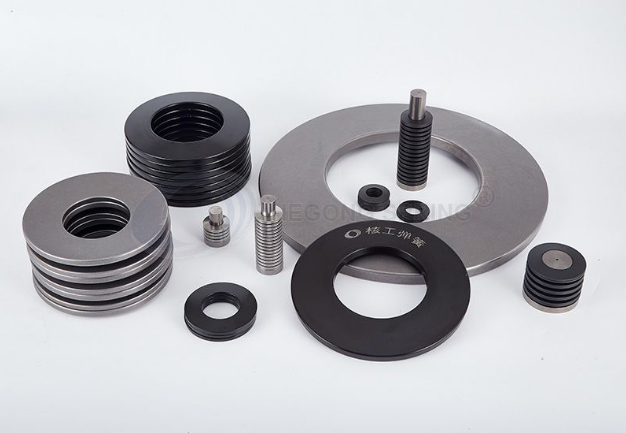In mechanical engineering, the quest for innovations that enhance the efficiency and durability of machines is perpetual. One such groundbreaking technology that has revolutionized the way we approach shock absorption and vibration control in various mechanical systems is the implementation of Disc Spring Rings.
These ingenious devices have become indispensable in many applications, offering unparalleled advantages in managing shocks and vibrations. Disc Spring Rings have emerged as the unsung heroes in ensuring the seamless operation of numerous mechanical structures by harnessing the principles of elasticity and mechanical design.
The Role of Disc Spring Rings in Absorbing Shocks and Vibrations
Disc Spring Rings, also known as Belleville washers, play a pivotal role in mechanical engineering by effectively absorbing shocks and vibrations. These deceptively simple yet ingeniously designed components are paramount in ensuring various mechanical systems’ durability, efficiency, and safety.
Flexibility and Elasticity
Their unique conical shape is at the core of Disc Spring Rings’ effectiveness, which provides inherent flexibility. When subjected to external forces such as shocks or vibrations, these rings deform, storing potential energy within their structure. This deformation enables them to absorb sudden impacts and vibrations, preventing the transmission of these forces to other machinery components.
Load Distribution
These excel in distributing loads evenly across their surface. When placed between components, they act as reliable spacers and cushioning elements. By distributing the applied force uniformly, these rings prevent localized stress points, which could lead to wear, deformation, or even structural failure. This load distribution capability is essential in heavy machinery where shocks and vibrations are common occurrences.
Energy Absorption
These possess remarkable energy-absorbing properties. During deformation, they store the energy generated by the external force. This stored energy is dissipated gradually as the force diminishes, ensuring a controlled release. This controlled dissipation is critical in preventing sudden movements or jolts, thereby maintaining stability and smooth operation in various applications.
Versatility in Applications
Its versatility extends across a wide array of industries. From automotive and aerospace to heavy industrial machinery, these rings find applications in suspension systems, clutches, brakes, and numerous other critical components. Their ability to absorb shocks and vibrations enhances the performance and longevity of these systems, making them indispensable in the modern engineering landscape.
Maintenance of Preload and Bolted Joints
These are often used in bolted joints to maintain proper preload. By compensating for thermal expansion, settlement, or relaxation of bolts over time, these rings ensure that the joints remain securely fastened. In particular, in situations subject to vibration and shock, this preventive step improves the joint’s integrity and considerably adds to the overall stability of the associated components.
Mechanical Principles of Disc Spring Rings
Conically curved washers called disc spring rings are frequently utilized in a variety of mechanical applications to dampen shocks and vibrations. They are designed to store and release energy efficiently due to their unique geometry and material properties. The underlying mechanical ideas of disc spring rings are examined in detail here:
- Design and Geometry
These are conical in shape, with a slight slope. This design allows them to compress radially when subjected to axial loads. Also, its thickness varies radially, creating a gradient. This gradient is crucial in determining the spring’s behavior under different loads.
- Material Properties
These are typically made from highly elastic materials like steel alloys. This high elasticity allows them to deform significantly under load and return to their original shape when removed. More so, the material must possess sufficient strength to withstand the applied loads without permanent deformation or failure.
- Elastic Deformation
When a load is applied axially to a disc spring, it undergoes elastic deformation. The conical shape allows for a distributed loading along the surface, preventing localized stress concentrations. Also, the disc spring loses thickness as a result of flattening due to the applied force. The spring will revert to its original shape when the load is released due to its elastic deformation.
- Energy Absorption Mechanisms
When a disc spring is compressed, it stores potential energy within its material due to elastic deformation. During the compression and decompression cycles, some energy is lost as heat due to internal friction and hysteresis in the material. This energy dissipation helps in dampening vibrations. Also, these provide damping effects by absorbing and dissipating energy as they undergo repeated compression and decompression cycles.
- Shock Absorption and Vibration Damping
These are effective in absorbing shocks because they can be designed to handle sudden, high loads by deforming elastically and then returning to their original shape after the shock has passed. Also, stabilizing and releasing energy efficiently allows disc spring rings to dampen vibrations in mechanical systems. They absorb vibrational energy during the compression phase and release it during the decompression phase, reducing the overall vibration levels.
- Preload and Stacking
By stacking multiple disc spring rings in series or parallel, engineers can adjust the preload and load-carrying capacity of the assembly, making them versatile for various applications. Also, stacking disc springs in different configurations alters the overall stiffness and load-deflection characteristics, allowing engineers to tailor the behavior of the spring assembly according to specific requirements.
Types Of Disc Spring Rings
Disc spring rings, a multitude of varieties exist, tailored to cater to diverse applications and load demands. Each specific type of disc spring ring possesses unique characteristics rendering it suitable for particular applications. The following enumerates the prevalent varieties of disc spring rings available:
- Plain Disc Spring Rings
These are the most basic types of disc spring rings with a flat, plain surface. They provide general-purpose load-bearing and shock absorption capabilities.
- Single Disc Spring Rings
These consist of a single disc, offering moderate load-bearing capacity. They are suitable for applications with limited space.
- Double Disc Spring Rings
These have two stacked discs, providing higher load-bearing capacity than single-disc springs. They are used in applications where a higher load needs to be supported.
- Nested Disc Spring Rings
These consist of multiple discs nested inside one another. This design provides substantial load-bearing capacity and is often used in heavy-duty industrial applications.
- Wave Disc Spring Rings
These are wavy or corrugated, providing better elasticity and deflection capabilities. They are suitable for applications with varying loads and where flexibility is required.
- Slotted Disc Spring Rings
These have slots or openings around the circumference, allowing for reduced stiffness and increased flexibility. These are used in applications where a progressive load or a controlled deformation is necessary.
- Serrated Disc Spring Rings
These have serrations on their edges, enhancing their grip and preventing slippage. This design is useful in applications where the disc spring ring needs to maintain a secure position.
Choosing Disc Spring Ring Manufacturers
There are numerous important considerations to bear in mind if you aim to guarantee that the components within your applications are of the utmost quality, utmost reliability, and operate at their optimal capacity. When choosing a supplier for disc spring rings, it is very essential to keep the following factors in mind:
- Quality and Standards
Verify that the producer complies with relevant industry-specific certifications and international quality standards, such as ISO (International Organization for Standardization). Processes for ensuring quality, the capacity to trace materials, and manufacturing standards are essential signs of a reliable firm.
- Experience and Reputation
Find high-quality disc spring ring suppliers with a history of providing these products. Long-standing businesses with a good track record are known for their dependability and consistency.
- Customization and Engineering Support
Consider manufacturers who offer customization services. Some applications require specific dimensions, materials, or special coatings. A manufacturer that can customize disc spring rings to your specifications and provide engineering support can be invaluable.
- Material Selection
Stainless steel, alloys, and other specialty materials, among others, are used to make disc spring rings. The application environment, load specifications, and requirements for corrosion resistance all play a role in the material choice. Make sure the company offers a variety of materials.
- Manufacturing Capabilities
Assess the manufacturer’s production capabilities. Modern manufacturing techniques, precision machinery, and advanced quality control processes are indicators of a reliable manufacturer. A manufacturer with state-of-the-art facilities is better equipped to deliver high-quality products consistently.
- Lead Times and Delivery
Consider the manufacturer’s lead times and delivery capabilities. Timely delivery is crucial, especially if your projects have strict deadlines. Inquire about their production capacity and ability to meet your delivery schedules.
- Customer Support and Communication
Evaluate the level of customer support provided by the manufacturer. Clear and open communication channels are essential for addressing concerns, discussing specifications, and resolving issues promptly.
- Cost and Value
Cost is an important concern but shouldn’t be the only one. Evaluate the manufacturer’s total worth by considering elements like quality, customization possibilities, and support services. Long-term savings can occasionally be achieved by temporarily increasing the price to compensate for greater quality and service.
- References and Reviews
Seek references or read online reviews if available. Feedback from other clients can provide valuable insights into the manufacturer’s performance and customer satisfaction.
Mastering Shocks and Vibrations with Disc Spring Rings from MISUMI
Mechanical engineers are constantly looking for ways to improve the functionality and longevity of their creations. Disc Spring Rings is one such groundbreaking innovation that has fundamentally changed how we approach shock absorption and vibration control in various mechanical systems. With their unmatched benefits in controlling shocks and vibrations, these inventive devices have proven vital in a wide range of applications.
Worry no more about finding a reliable and high-quality disc spring rings manufacturer – MISUMI is the key to your engineering needs. With a stellar reputation in the industry, MISUMI stands as a beacon of excellence, providing top-notch mechanical components for a wide array of applications. Visit MISUMI’s website today at https://th.misumi-ec.com and unlock a world of possibilities for your engineering endeavors. If you have problems with leaks, you may also avail of its O-rings, a device that helps prevent leaks. Experience engineering excellence like never before!








